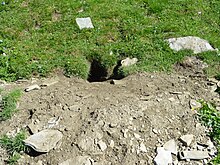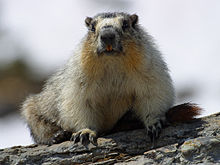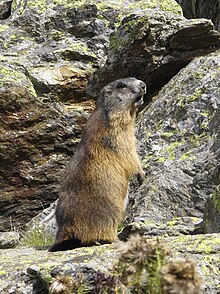Marmots
| Marmots | ||||||||||||
|---|---|---|---|---|---|---|---|---|---|---|---|---|

Alpine marmot ( Marmota marmota ) |
||||||||||||
| Systematics | ||||||||||||
|
||||||||||||
| Scientific name | ||||||||||||
| Marmota | ||||||||||||
| Blumenbach , 1779 |
The Murmeltiere ( Marmota ), Switzerland also Munggen , also in Upper Bavaria and the adjacent Salzburg Mankei are called a fourteen species existing genus to 50 centimeters long to Real Erdhörnchen (Marmotini), which in Eurasian and North America are common. The marmot species are primarily inhabitants of cold steppes . The today only in mountainous areas beyond the tree line living alpine marmots came during the Pleistocene ice age in the European lowlands of the Pyrenees to the Ukraine before. In contrast, it was missing in the Alps, which were covered with a thick layer of ice. With the end of the Ice Age, only the high alpine regions of the Alps offered this type of suitable habitat (Ice Age relic ). Marmots can live up to 15 years.
features
For rodents , marmots are very large: Depending on the species, they have a head-trunk length of 30 to 60 centimeters, plus a 10 to 25 centimeter long tail. The weight is between three and seven kilograms. The color of the marmot fur differs from species to species, but is mostly brownish. The body of the animals is stocky with a short tail and short, rounded ears. The legs are also short and stocky. The front legs have only four toes and the thumb is completely reduced, the middle finger is the longest finger and the claws are long and designed for digging. The rear extremities have five toes. The females have five pairs of teats .
| 1 | · | 0 | · | 2 | · | 3 | = 22 |
| 1 | · | 0 | · | 1 | · | 3 |
The skull is strong and flat, almost triangular. The eye sockets are long, the postorbital process is strong and slightly curved downwards. The sagittal ridge is well developed and the anterior area branches and connects it with the postorbital process. The occipital part is clearly elongated. The bony palate is longer than half the total length of the skull. The type has in each jaw half each have a reshaped to a incisor tooth incisor (incisor), it follows a diastema and two in the upper jaw and the lower jaw each a premolar and three molars . The incisor teeth are strong and covered with yellow enamel on the front . The first premolar of the upper jaw is very strong and almost twice as large as the following second premolar. Among the molars of the upper jaw, the third is the largest, the lower molars each have two lateral tips.
Like the ground squirrel (genus Spermophilus ), the marmots also have a penis bone that is almost S-shaped. The tip has laterally irregular denticles .
distribution and habitat
In Central Europe , marmots are native to the high mountains ; In Asia , too, some species have adapted to life in alpine heights. More typical of the marmot genus, however, are the species that inhabit the grass steppes, for example the steppe marmot ( Marmota bobak ), which occurs in eastern Poland.
The distribution area is relatively closed from Eastern Europe to Northern and Central Asia to Eastern Siberia and Xinjiang . In Central Europe there are only wild marmots in the Alps, the Carpathians and the High Tatras, as well as marmots introduced in the Pyrenees . In North America most species live in subarctic latitudes of Canada ; the woodchuck is common throughout the northern half of the United States as well as southern parts of Canada. All marmots live in temperate and arctic latitudes in the northern hemisphere and are absent in warmer regions.
Way of life
Marmots are squirrels that live above and below ground. They are diurnal and all species hibernate .
The marmot burrows

Marmots build very extensive systems of passages, which can consist of escape tubes and separate permanent structures. It is often difficult to differentiate between them, as not every building is completed and used, especially since dead corridors, the “toilets”, are also present. The corridors can be 10 to 70 meters long; the record measured so far was a tunnel 113 meters long.
During the day the marmots leave their burrows. They are mainly active on the ground and can hardly climb. Their food is grass and herbs , less often fruits, seeds and insects .
Heat stress

Marmots have only a few sweat glands and do not pant . Various studies indicate that marmots do not tolerate high temperatures and are easily exposed to heat stress . The American yellow-bellied marmot shows symptoms of heat stress from an ambient temperature of 20 ° C. Alpine marmots can, however, be observed sunbathing on rocks or in front of their burrows, mostly lying flat on the ground. However, this behavior serves to ward off parasites. Their other activity pattern indicates that Alpine marmots also avoid the heat. On hot days they can only be observed outside their burrows in the cooler off-peak times.
Social behavior
The social behavior of the marmots differs considerably from species to species. The woodchuck is a solitary animal that defends its den against conspecifics. In the yellow-bellied marmot ( Marmota flaviventris ) a single male lives together with related females; Here, too, the males are aggressive towards other members of their own sex who do not allow them to get near the burrow.
However, like the Alpine marmot ( Marmota marmota ) , the majority of marmots live in colonies consisting of a dominant pair and their younger relatives. Marmots greet each other by rubbing their noses together and sticking their heads together. After about two years, the adult marmots leave the colony; then they can try to win the leadership of a foreign colony, for which they drive away the dominant male there and kill its offspring . Marmots communicate with each other by screams generated in the larynx, which humans perceive as whistling tones and which can easily be mistaken for bird calls. The screams are also uttered to announce danger. Depending on the social rank of the caller, the result is flight or even lack of reaction.
After a gestation period of thirty days, marmots give birth to two to five young, with the solitary species having larger litters than the colonizing ones.
Hibernation
Marmots hibernate for a long time, which can last between six and seven, but also up to nine months. For this purpose, the sleeping kettle is padded with soft grass in which the animals curl up. For this long rest period, they eat large reserves of fat during the few summer months. In the seasonal resting phase, the intestines and stomach can shrink by half, saving energy. During hibernation, breathing drops to about two puffs per minute and the heartbeat from 200 to 20 beats per minute. The energy consumption drops to less than ten percent. Around 1200 grams of body fat is enough for the winter. As soon as the food no longer provides sufficient energy in autumn and the fat storage cells are filled to the maximum, the marmots go into hibernation. This time often coincides with the first cold spell or the first snowfall. Awakening is triggered by the outside temperature.
Evolution and systematics
External system
|
Phylogenetic systematics of the Marmotini according to Herron et al. 2004
|
The marmots are a genus of the squirrels , where they are assigned to the ground squirrels (Xerinae) and therein the real ground squirrels (Xerini). The first scientific description of the genus was made by Johann Friedrich Blumenbach in 1779, but the Alpine marmot ( M. marmota ) and the woodchuck ( M. monax ) were already described by Carl von Linné in his 10th edition of the Systema Naturae in 1758 and there to the mice assigned to the genus Mus .
The marmots were confirmed as a monophyletic group in a molecular biological study in 2004 and identified as a sister group of the entire Marmotini with the exception of the antelopesmophilus ( Ammospermophilus ) and the genera Notocitellus , Otospermophilus and Callospermophilus originally assigned to the ground squirrels .
Internal system
Marmots have been fossilized from North America since the Miocene (23.03 to 5.33 million years ago). They made the transition to Eurasia several times : in the late Miocene, in the Pliocene (5.33 to 1.8 million years ago) and most recently in the Pleistocene (1.8 million to 11,500 years ago).
|
Phylogenetic system of the genus Marmota according to Brandtler & Lyopunova 2009
|
Within the marmots, fifteen species are currently distinguished, which, depending on the system, are divided into two sub-genera. Here are the North American species , hoary marmot ( M. caligata ), the yellow-bellied marmot ( M. flaviventris ), the Olympic marmot ( M. olympus ) and the Vancouver Island Marmot ( M. vancouverensis ) as Petromarmota compared with all other species in the subgenus Marmota to be classified. Phylogenetic studies confirm the closer relationship of the Marmota Petromarmota species as a taxon within the marmots that is opposite to the other species. Despite some uncertainties within the cladogram, this also confirms the origin of the marmots in North America as well as a common taxon of the species that live in Europe and Asia.
The following species are currently distinguished within the marmots:
- Gray marmot ( M. baibacina ), eastern Kazakhstan , Xinjiang , Mongolia
- Steppe marmot ( M. bobak ), Eastern Europe to Central Asia
- Alaska marmot ( M. broweri ), northern Alaska
- Ice gray marmot ( M. caligata ), Alaska, British Columbia , Washington
- Black hat marmot ( M. camtschatica ), northeastern Siberia
- Long-tailed marmot ( M. caudata ), Central Asia
- Yellow-bellied marmot ( M. flaviventris ), southwestern Canada
- Himalayan marmot ( M. himalayana ), Himalaya
- Forest steppe marmot ( Marmota kastschenkoi ), forest steppes in northern Russia
- Alpine marmot ( M. marmota ), Alps , Carpathian Mountains , High Tatras , Pyrenees
- Menzbier's marmot ( M. menzbieri ), Tianshan
- Woodchuck ( M. monax ), Canada , northern United States
- Olympic marmot ( M. olympus ), Olympic Peninsula (United States)
- Siberian marmot ( M. sibirica ), southern Siberia, Mongolia
- Vancouver marmot ( M. vancouverensis ), Vancouver Island
The Asian species in particular are not uncontroversial in their delimitation. Gray, Himalayan and Siberian marmots are occasionally listed as subspecies of the steppe marmot and the forest steppe marmot does not appear as an independent species in older classifications.
Agriculture and species protection
The population development of the species is very different. The woodchuck has become increasingly common in North America over the past few decades. The deforestation of the forests came his stocks benefited. It is now considered a pest in parts of the United States because it eats grain and its tunnels are so close to the surface that livestock and farm machinery break in regularly.
The other types are much rarer. The Alpine marmot has disappeared from numerous mountains in Europe over the past centuries. Marmot skins are also processed into furs , which is why the steppe marmot was close to extinction in the 1920s; but its stocks were able to recover.
Two types of the IUCN as worthy of protection out: the Menzbier marmot in the status of "endangered" ( vulnerable ) and the Vancouver Island Marmot in the status of "threatened with extinction" ( critically endangered ). Only about 130 specimens of the latter live, only about 35 of them in freedom.
The alpine marmot is a huntable game in Austria and Switzerland and is actively hunted. In Germany it is subject to hunting law, but is spared all year round.
use
Marmot used to be widely used in the kitchen. Even if this has become rare today, a number of recipes can be found on the Internet. The official website of the Austrian state of Tyrol (page heading “Marmots - so sweet and delicious!”) Advertised tourists with a cooking recipe until about 2011: “Marmot meat is highly recommended! Well prepared it is a delicacy. ”It is probably thanks to the effort in preparation that the marmot is no longer in cookbooks today. "Fresh meat has such a strong earthy game taste that it causes disgust to those who are not used to this dish," says Brehms Tierleben. Above all, the fatty tissue is considered barely edible. The animal, which was therefore well defatted, was therefore additionally smoked or boiled before roasting and the cooking water was thrown away.
The fat is considered in folk medicine to be effective against coughs, stomach ailments, nausea, for blood purification or generally for strengthening; Externally ( marmot ointment ) against pain in the limbs, chilblains or strained tendons.
Surname
The name “marmot” etymologically has nothing to do with the marble or the verb “murmeln”. It goes back to the Old High German "murmunto", which in turn is borrowed from the Latin mus montis ("mountain mouse"). The female marmot is sometimes called "cat" , the male "bear" and young animals "monkey" or "monkey". In Switzerland, marmots are also called mongoose (singular: Mungg ).
See also
- Groundhog Day (February 2nd)
- And the marmot greets you every day
- Narcolepsy (marmot syndrome)
supporting documents
- ↑ a b c d Robert S. Hoffmann, Andrew T. Smith: Genus Marmota. In: Andrew T. Smith , Yan Xie: A Guide to the Mammals of China. Princeton University Press, Princeton NJ 2008, ISBN 978-0-691-09984-2 , pp. 189-190.
- ^ The Parliament Hill Cat Colony .
- ^ A b c Walter Arnold: General biology and way of life of the Alpine marmot (Marmota marmota). In Monika Preleuthner, Gerhard Aubrecht (ed.): Murmeltiere (= catalog of the Upper Austrian National Museum. NF # 146 =. Stapfia. Vol. 63). Biology Center, Linz 1999, ISBN 3-85474-044-1 , pp. 1-20, PDF (2.7 MB) on ZOBODAT
- ^ A b Matthew D. Herron, Todd A. Castoe, Christopher L. Parkinson: Sciurid phylogeny and the paraphyly of holarctic ground squirrels (Spermophilus). Molecular Phylogenetics and Evolution 31, 2004; Pp. 1015-1030. ( doi : 10.1016 / j.ympev.2003.09.015 , full text , PMID 15120398 )
- ^ Carl von Linné : Systema naturae. 10th edition, 1758; Volume 1, pp. 60, 63-64 ( digitized version ).
- ↑ a b c O.V. Brandler, EA Lyapunova: Molecular phylogenies of the genus Marmota (Rodentia Sciuridae): comparative analysis. Ethology Ecology & Evolution 21, 2009; Pp. 289-298. ( Full text )
- ↑ Scott J. Steppan, Mikhail R. Akhverdyan, Elena A. Lyapunova, Darrilyn G. Fraser, Nikolai N. Vorontsov, Robert S. Hoffmann, Michael J. Braun: Molecular phylogeny of the marmots (Rodentia: Sciuridae): tests of evolutionary and biogeographic hypotheses. Systematic Biology 48 (4), 1999; Pp. 715-734. ( Full text )
- ^ Richard W. Thorington Jr., John L. Koprowski, Michael A. Steele: Squirrels of the World. Johns Hopkins University Press, Baltimore MD 2012, ISBN 978-1-4214-0469-1 , pp. 271-289 .
- ↑ The alpine marmot spreads into the Catalan Pyrenees . EurekAlert !, Science News
- ↑ Marmota menzbieri in the endangered Red List species the IUCN 2009 Posted by: K. Tsytsulina, 2008. Accessed November 7 in 2009.
- ↑ Marmota vancouverensis in the endangered Red List species the IUCN 2009 Posted by: D. W. Nagorsen, NatureServe, 2008. Accessed November 7 in 2009.
- ↑ Marmots - so cute! And delicious. ( Memento from February 2, 2010 in the Internet Archive )
- ^ Alfred Brehm : Brehms Thierleben . General customer of the animal kingdom. Second Volume, First Section: Mammals. Third volume: hoofed animals, sea mammals. Verlag des Bibliographisches Institut, Leipzig 1883, pp. 300–305, here online .
- ↑ Marmots: Dwarfs with a Whistle In: 3sat.de accessed on July 23, 2014
- ↑ As many Munggen as not shot since 1954 In: Tages-Anzeiger of October 31, 2009
literature
- Richard W. Thorington Jr., John L. Koprowski, Michael A. Steele: Squirrels of the World. Johns Hopkins University Press, Baltimore MD 2012, ISBN 978-1-4214-0469-1 , pp. 271-289 .
- Dmitri Iwanowitsch Bibikow : The marmots of the world. Marmota. (= Die Neue Brehm-Bücherei. Volume 388). 2nd, completely revised and expanded edition. Westarp-Wissenschaften et al., Magdeburg et al. 1996, ISBN 3-89432-426-0 .
- Hanns-Peter Mederer: Why the marmot needs hay. Knowledge and beliefs about an Allgäu cave dweller. In: The beautiful Allgäu. No. 3, 1992, pp. 29-32.
- Monika Preleuthner, Gerhard Aubrecht (Ed.): Marmots (= catalog of the Upper Austrian State Museum. NF No. 146 = Stapfia. Vol. 63). Biology Center, Linz 1999, ISBN 3-85474-044-1 , online at ZOBODAT (exhibition catalog).
Web links
- Marmot in the nature lexicon
- Marmots on the Hochkönig / Salzburg Video on YouTube




